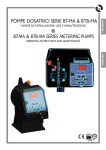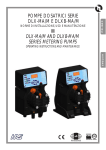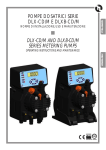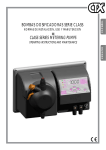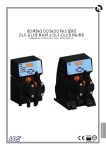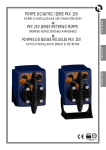Download DLS CC-2 Operating instructions
Transcript
POMPE DOSATRICI SERIE DLS NORME DI INSTALLAZIONE, USO E MANUTENZIONE ■ DLS SERIES METERING PUMPS OPERATING INSTRUCTIONS AND MAINTENANCE NORMES D’INSTALLATION, EMPLOI ET ENTRETIEN ■ BOMBAS DOSIFICADORAS SERIE DLS ENGLISH ■ POMPES DOSEUSES SERIE DLS ESPAÑOL FRANCAIS NORMAS PARA LA INSTALACIÓN, USO Y MANTENIMIENTO UNI EN ISO 9001 - 9190.ETAD INDEX pag. 28 28 28 28 28 29 29 2.0 -DLS SERIES METERING PUMPS 2.1 - OPERATION 2.2 - COMMON FEATURES 2.3 - LIQUID ENDS MATERIALS 2.4 - DESCRIPTION OF THE TABLE 30 30 30 31 31 3.0 - INSTALLATION 3.1 - INJECTION VALVE INSTALLATION DIAGRAM 3.2 - SERVICE CONNECTOR WIRING DIAGRAMS AND FUNCTIONS 32 33 34 4.0 - MAINTENANCE 35 5.0 - HOW TO OPERATE WHEN DOSING SULPHURIC ACID 35 6.0 - TROUBLE-SHOOTING COMMON TO DLS SERIES 6.1 - MECHANICAL FAULTS 6.2 - ELECTRICAL FAULTS 36 36 36 7.0 - MANUALLY OPERATED METERING PUMP DLS-MA 7.1 - ACCESSORIES 7.2 - TYPICAL INSTALLATION 7.3 - PUMP CONTROLS 7.4 - PUMP CONTROLS DESCRIPTIONS 7.5 - LEVEL CONTROL 7.6 - DLS-MA TROUBLE SHOOTING 37 37 37 38 38 38 38 8.0 - VOLUMETRIC PROPORTIONAL DOSING PUMPS 8.1 - DLS-F VOLUMETRIC PROPORTIONAL DOSING PUMPS 8.1.1 - ACCESSORIES 8.1.2 - TYPICAL INSTALLATION 8.1.3 - PUMP CONTROLS 8.1.4 - DLS-F PUMP CONTROLS DESCRIPTIONS 8.1.5 - LEVEL CONTROL 8.1.6 - DLS-F PUMP ELECTRICAL FAULTS 8.2 - DLS-VFT PROPORTIONAL DOSING PUMP TO AN EXTRENAL PULSE 8.2.1 - ACCESSORIES 8.2.2 - TYPICAL INSTALLATION 8.2.3 - PUMP CONTROLS 8.2.4 - LEVEL CONTROL 8.2.5 - DLS-VFT PUMP ELECTRICAL FAULTS 39 39 39 39 40 40 40 41 42 42 42 43 44 44 9.0 - PROPORTIONAL PUMP REGULATED BY A CURRENT SIGNAL DLS-CC 9.1 - ACCESSORIES 9.2 - TYPICAL INSTALLATION 9.3 - LEVEL CONTROL 9.4 - PUMP CONTROLS 9.5 - CALIBRATION 9.6 - PARAMETER SETTING 9.7 - DLS-CC PUMP ELECTRICAL FAULTS 45 45 45 45 46 46 46 47 10.0 - DOSING PUMP WITH PH CONTROLLER DLS-PH 10.1 - ACCESSORIES 10.2 - TYPICAL INSTALLATION 10.3 - LEVEL CONTROL 10.4 - PUMP CONTROLS 10.5 - COMMISSIONING THE PUMP 10.6 - CALIBRATION 10.7 - DLS-PH SPECIFIC ELECTRICAL FAULT 48 48 48 48 49 49 49 49 11.0 - DOSING PUMP WITH RX CONTROLLER DLS-RX 11.1 - ACCESSORIES 11.2 - TYPICAL INSTALLATION 11.3 - LEVEL CONTROL 11.4 - PUMP CONTROLS 11.5 - COMMISSIONING THE PUMP 11.6 - CALIBRATION 11.7 - DLS-RX SPECIFIC ELECTRICAL FAULT 50 50 50 50 51 51 51 51 12.0 - ELECTRODES HOLDERS 52 13.0 - PH ELECTRODE CLEANING AND MAINTENANCE 13.1 - RECONDITIONING 52 52 EXPLOSED VIEWS 105-107 • 27 • ENGLISH 1.0 - HINTS AND WARNING 1.1 - WARNING 1.2 - SHIPPING AND TRANSPORTING THE PUMP 1.3 - PROPER USE OF THE PUMP 1.4 - RISKS 1.5 - TOXIC AND/OR DANGEROUS LIQUID DOSAGE 1.6 - ASSEMBLING AND DISMANTLING THE PUMP 1.0 - HINTS AND WARNINGS Please read the warning notices given in this section very carefully, because they provide important information regarding safety in installation, use and maintenance of the pump. • Keep this manual in a safe place, so that it will always be available for further consultation. • The pump complies with EEC directives No.89/336 regarding "electromagnetic compatibility" and No.73/23 regarding "low voltages", as also the subsequent modification No.93/68. N.B. The pump has been constructed in accordance with best practice. Both its life and it electrical and mechanical reliability will be enhanced if it is correctly used and subjected to regular maintenance. 1.1 - WARNING: Any intervention or repair to the internal parts of the pump must be carried out by qualified and authorized personnel. The manufactures decline all responsibility for the consequences of failure to respect this rule. GUARANTEE: 1 year (the normal wearing parts are excluded, i.e.: valves, nipples, tube nuts, tubing, filter and injection valve). Improper use of the equipment invalidates the above guarantee. The guarantee is exfactory or authorized distributors. 1.2 - SHIPPING AND TRANSPORTING THE PUMP The pump should always be moved in a vertical (and never in a horizontal) position. No matter what the means of transport employed, delivery of the pump, even when free to the purchaser's or the addressee's domicile, is always at the purchaser's risk. Claims for any missing materials must be made within 10 (ten) days of arrival, while claims for defective materials will be entertained up to the 30th (thirtieth) day following receipt. Return of pumps or other materials to us or the authorized distributor must be agreed beforehand with the responsible personnel. 1.3 - PROPER USE OF THE PUMP • The pump should be used only for the purpose for which it has been expressly designed, namely the dosing of liquid additives. Any different use is to be considered improper and therefore dangerous.The pump should not therefore be used for applications that were not allowed for in its design. In case of doubt, please contact our offices for further information about the characteristics of the pump and its proper use. The manufactures cannot be held responsible for damage deriving from improper, erroneous or unreasonable use of the pump. 1.4 - RISKS • After unpacking the pump, make sure it is completely sound. In case of doubt, do not use the pump and contact qualified personnel. The packing materials (especially bags made of plastics, polystyrene, etc.) should be kept out of the reach of children: they constitute potential sources of danger. • Before you connect the pump, make sure that the voltage ratings, etc., correspond to your particular power supply. You will find these values on the rating plate attached to the pump. • The electrical installation to which the pump is connected must comply with the standards and good practice rule in force in the country under consideration. • Use of electrical equipment always implies observance of some basic rules: In particular: 1 - do not touch the equipment with wet or damp hands or feet; 2 - do not operate the pump with bare feet (Example: swimming pool equipment); 3 - do not leave the equipment exposed to the action of the atmospheric agents; 4 - do not allow the pump to be used by children or unskilled individuals without supervision; • In case of breakdown or improper functioning of the pump, switch off, but do not touch. Contact our technical assistance for any necessary repairs and insist on the use of original spares. Failure to respect this condition could render the pump unsafe for use. • When you decide to make no further use of an installed pump, make sure to disconnect it from the power supply. Before carrying out any service on the item, check: 1. Disconnect the pins from the mains or by means of a onnipolar switch with 3 mm minimum distance between the contacts. (Fig. 4). 2. Relieve all the pressure from the pump head and injection tube. 3. Drain or flush all dosing liquid from the pump head. This operation can also be done with the pump disconnected from the plant by turning the pump upside-down for 15 to 30 seconds and without connecting the tubing to the nipples: if this operation is not possible, dismount and remount the pump head using the four mounting screws. In event of possible losses in the hydraulic system of the pump (breakage of the "O" ring gasket, the valves or the hoses) the pump should immediately be brought to a stop, emptying and depressurizing the delivery hose while taking all due safety precautions (gloves, goggles, overalls, etc.). • 28 • 1.5 - TOXIC AND/OR DANGEROUS LIQUID DOSAGE To avoid risk from contact with the hazardous liquids or toxic fumes, always adhere to the notes in this instruction manual: • Follow the instructions of the dosing liquid manufacturer. • Check the hydraulic part of the pump and use it only if it is in perfect condition. • Use only the correct materials for the tubing, valves and seals to suit the liquid to be dosed; where possible shield the tubing with PVC conduit. • Before disconnecting the metering pump, make sure to flush out and neutralize the pump head with the proper reagent liquid. 1.6 - ASSEMBLING AND DISMANTLING THE PUMP 1.6.2 - DISMANTLEMENT Proceed as follows before you dismantle the pump or perform any other operation on it: 1. Disconnect the pins from the mains or by means of a onnipolar switch with 3 mm minimum distance between the contacts. (Fig. 4). 2. Relieve all the pressure from the pump head and injection tube. 3. Drain or flush all dosing liquid from the pump head. This operation can also be done with the pump disconnected from the plant by turning the pump upside-down for 15 to 30 seconds and without connecting the tubing to the nipples: if this operation is not possible, dismount and remount the pump head using the four mounting screws. (Fig. 11). This operation calls for special attention, and you should therefore consult the drawings in Appendix and Chapter 1.4“RISKS” before you commence the work. • 29 • ENGLISH 1.6.1 - ASSEMBLY All our metering pumps are normally supplied in fully assembled trim. For greater clarity, please consult the exploded view of the pump appended at the end of the manual, which shows all the pump details and the nomenclature used therefor, thus providing a complete overview of all the pump components. These drawings are in any case quite indispensable whenever defective parts have to be re-ordered. For the same purpose, the appendix also contains other drawings showing the hydraulic parts (pump head and valves). Fig. 1 2.0 - DLS SERIES METERING PUMPS This series include: DLS-MA: constant flow “manual/on-off” mode; DLS-F: proportional pump to an external pulse; DLS-VFT: microprocessor proportional pump with four different operating modes: manual, (1 x n - M), (1 x n), (1 : n); DLS-CC: microprocessor proportional pump based for external mA signal. DLS-PH: metering pump with integral pH meter; DLS-RX: metering pump with integral Redox meter; 2.1 - OPERATION The metering pump is activated by a teflon diaphragm mounted on a piston of an electromagnet. When the piston of the electromagnet is attracted, a pressure is produced in the pump body with an expulsion of liquid from the discharge valve. Once the electric impulse is finished a spring brings the piston back to the initial position, with a recall of liquid through the suction valve. As the operation is simple the pump does not need lubrication, therefore maintenance is reduced almost to zero. The materials used for the construction of the pump make it particularly suitable for aggressive. liquids. The metering pump has been designed to feed liquids with capacities from 0 to 80 l/h and pressures from 0 to 20 bar (depending on the model selected). The capacity can be changed by a special manually-operated control which regulates the number of injections per minute (from 0 to approx 100/min). 2.2 • • • • • • • • - COMMON FEATURES The products are manufactured according regulation. IP 65 protection. The casing is in aluminium protected with epoxy paint. Control panel protection assured by a transparent policarbonate cover with gasket. Level control setting included (supplied without probe). Standard power supply: 230 V a.c.50 Hz single phase. Optional power supply: 240 V a.c.50-60 Hz single phase; 120 V a.c. 50-60 Hz single phase. On request mechanical stroke length adjustment system, this control provides accurate capacity adjustment. (Fig. 2). Pump head made of PVC. Fig. 2 • 30 • 2.3 - LIQUID ENDS MATERIALS - DIAPHRAGM: PTFE - PUMP HEAD: Polypropylene (PVC for 05-20), upon request: PVC, 316 Stainless Steel, PTFE. Stroke Adjustment: PVC pump head - NIPPLES: polypropylene - FILTER: polypropylene - INJECTION NIPPLE: polypropylene - SUCTION HOSE: PVC - flexible - DISCHARGE HOSE: polyethylene - VALVES: “lip”type viton upon request available in EPDM (Dutral), NBR, Silycon. - “Ball Check” VALVES upon request type in SS 316 and Glass PYREX. Available with Spring Return and “KALRETZ”Valve. - SEALS: viton upon request EPDM (Dutral), NBR, Silycon, PTFE only for ball checks valves * ( ) * ( ) * ( ) * 2 3 4 5 6 Tipo Type Portata max Max flow Pressione max Max press Max imp./min. Max imp./min. Dosaggio per imp. Output per stroke Corsa Stroke l/h bar ml mm m 1 3 5 5 5 10 10 15 20 30 50 80 10 10 10 15 20 07 10 05 05 04 03 01 100 160 160 160 160 160 160 160 160 180 180 180 0.16 0.31 0.52 0.52 0.52 1.04 1.04 1.56 2.08 2.80 4.60 7.40 0.8 0.8 1.0 1.8 1.5 1.4 1.1 2.2 2.2 1.4 1.7 2.4 1.5 2.0 2.0 2.0 2.0 2.0 2.0 2.0 2.0 1.5 1.5 1.5 01-10 03-10 05-10 05-15 05-20 10-07 10-10 15-05 20-05 30-04 50-03 80-01 7 8 Altez. aspiraz. Suction height 9 10 11 Peso netto Net weight Aliment. elettr. standard Standard power supply Potenza ass. Power comp. Corrente ass. Current comp. Volts/Hz Watts Ampere kg 40 60 60 93 115 60 93 111 111 124 124 124 0.18 0.26 0.26 0.39 0.48 0.26 0.39 0.48 0.48 0.54 0.54 0.54 4.2 4.2 4.2 4.7 5.2 4.2 4.7 5.2 5.2 5.7 5.7 5.7 230 V 230 V 230 V 230 V 230 V 230 V 230 V 230 V 230 V 230 V 230 V 230 V 50 - 60 Hz 50 - 60 Hz 50 - 60 Hz 50 - 60 Hz 50 - 60 Hz 50 - 60 Hz 50 - 60 Hz 50 - 60 Hz 50 - 60 Hz 50 - 60 Hz 50 - 60 Hz 50 - 60 Hz * Pump supplied with manual air bleed pump head ( ) Fig. 3 2.4 - DESCRIPTION OF THE TABLE (Fig. 3) Column 1 - Pump type 2 - Metering pump max flow rate (l/h) 3 - Max working pressure (bar) 4 - Pulse/minute 5 - Injection volume per stroke (ml or cc) 6 - Piston stroke length (mm) 7 - Suction height (m) 8 - Standard power supply (Volts and Hz) Other power supplies can be made upon request 9 - Power consumption (Watts) 10 - Absorbed current I (Ampere) 11 - Weight in kg Low and medium flow rates 05-20 High flow rates bar bar 20 30-04 05-15 6 50-03 15 01-10 03-10 5 05-10 10-10 10 4 80-01 10-07 3 15-05 20-05 2 5 1 i.v.p. i.v.p. 0 0 0 5 10 15 20 0 l/h 20 40 60 80 100 l/h Fig. 3a The diagrams of fig. 3a indicate max metering pump flow variation in relation to the working pressure in the plant; the diagrams also include injection valve losses. I.V.P. Due to production requirements the technical characteristics of our equipment at maximum ratings can vary with a tolerance of 5% which must be taken into account when choosing the type of pump. • 31 • ENGLISH ( ) * ( ) * ( ) 1 3.0 - INSTALLATION a. - Install the pump in a dry place and well away from sources of heat and, in any case, at environmental temperatures not exceeding 40°C. The minimum operating temperature depends on the liquid to be pumped, bearing in mind that it must always remain in a liquid state. b. - Carefully observe the regulations in force in the various countries as regards electrical installations (Fig.4). When the supply cable is devoid of a plug, the equipment should be connected to the supply mains by means of a single-pole circuit breaker having a minimum distance of 3 mm between the contacts. Before accessing any of the electrical parts, make sure that all the supply circuits are open. BLUE BROWN YELLOW/GREEN Fig. 4 c.- Locate the pump as shown in fig. 5 bearing in mind that it may be installed either below or above the level of the liquid to be dosed, though the level difference should not exceed 2 meters. When the process plant in which the pump is installed is operating at atmospheric pressure (no back pressure) and the chemical tank is situated above the plant (Fig. 6), the condition of the injection valve should be checked at regular intervals, because excessive wear and tear could cause additive to drip into the plant even when the pump is shut down. If the problem persist, install a properly calibrate counter-pressure valve (C) between injection point and the valve. In the case of liquids that generate aggressive vapors, do not install the pump above the storage tank unless the latter is hermetically sealed. Fig. 5 Fig. 6 d. - The discharge nipple will always remain in the upper part of the pump. The suction nipple, which serves to attach the hose (with filter) leading into the chemical tank, will therefore always be situated in the lower part of the pump. Fig. 7 e. - Remove the protection caps from the two nipples, slide the hoses over the connectors, pushing them right home, and then fix them with appropriate tube nuts. (Fig. 7). • 32 • Whenever the pump is dismantled from the process plant, you will be well advised to replace the caps on the connectors to avoid residual liquid being spilled. Before attaching the delivery hose to the plant, prime the metering pump by going through the sequence shown in Fig. 8. Before finalizing the installation of the discharge hose, make sure that the pump strokes will not cause it to move and bump into rigid bodies. In case of priming difficulties, use a normal syringe to suck liquid from the discharge nipple while the pump is in operation, continuing until you actually see the liquid rise in the syringe. Use a short length of suction hose to connect the syringe to the discharge nipple. In case of a pump equipped with an air bleed valve, unscrew the air relief valve B up to all the air in the pump head will be out. f. - Try to keep both the suction and discharge hose as straight as possible, avoiding all unnecessary bends. g. - Select the most appropriate injection point on a pipe of the plant to be treated and there fit a 3/8" female steel gas thread connector (similar to BSPm). This connector is not supplied with the pump. Screw the injection valve to the gas connector, inserting a gasket as shown in Fig. 9. Then connect the discharge hose to the conical connector on the injection valve and fix it with the supplied tube nut G. The injection valve also acts as no return valve by means of a cilinder sleeve (elastomer, standard supplied in Viton). N.B. The sleeve D must not be removed. Fig. 9 3.1 - INJECTION VALVE INSTALLATION DIAGRAM Fig. 9 A - Process plant C - Injection valve M - Conical connector for attaching the discharge hose N - 3/8" female steel gas thread connector G - Hose tube nut T - Polyethylene hose D - Cilinder sleeve (no return valve) • 33 • ENGLISH Fig. 8 3.2 - SERVICE CONNECTOR WIRING DIAGRAMS AND FUNCTIONS Pump Model Female service connector wire assembly Relay service output connection N.C. Common DLS-PH DLS-RX Configuration: Pin 1 = Normally open “ 2 = Normally closed “ 3 = Common = No connection N.O. Pos. 1 DLS-MA DLS-F DLS-VFT DLS-CC DLS-PH DLS-RX Functions and technical informations Level probe connection Configuration: Pin 1 = No connection “ 2 = No connection “ 3 = Level probe wire “ 4 = Level probe wire To level probe Pos. 2 Input mA signal connection Input mA signal DLS-CC Pos. 3 Configuration: Pin 1 = No connection “ 2 = No connection “ 3 = (+) mA signal wire “ 4 = (-) mA signal wire Output mA signal connection Uscita Output segnale mA signal in mA DLS-PH DLS-RX Pos. 3 Configuration: Pin 1 = No connection “ 2 = No connection “ 3 = (+) mA signal wire “ 4 = (-) mA signal wire Pulse emitting Water Meter connection To pulse emitting Water Meter DLS-F DLS-VFT Pos. 3 • 34 • Configuration: Pin 1 = No connection “ 2 = No connection “ 3 = Water Meter signal wire “ 4 = Water Meter signal wire 4.0 - MAINTENANCE ENGLISH 1. Periodically check the chemical tank level so as to avoid the pump operates without liquid. This would not damage the pump, but may damage the process plant due to lack of chemical. DLS series dosing pumps are all supplied with level control setting. The level switch is not included therefore to be ordered separately. Level control stops pump operation once the level into the chemical is lower then the level switch,activating a L.E.D. on the pump (DLS-CC pumps also activates an acoustic alarm). 2. Check the pump operating condition at least every 6 months, pump head position, screws, bolts and seals; check more frequently where aggressive chemicals are pumped, especially: - pulse and power L.E.D.; - the additive concentration in the process plant; a reduction of this concentration could be caused by the wearing of the valves, in which case they need to be replaced (Fig. 11) or by the clogging of the filter which then has to be cleaned as in point 3 here below. Fig. 11 3. The Company suggests periodically cleaning off the hydraulic parts (valves and filter). We cannot say how often this cleaning should be done as it depends on the type of application, we also cannot suggest what cleaning agent to use as this will depend on the additive used. Operating suggestions when dosing sodium hypochlorite (most frequent case): a - disconnect the pins from the mains or by means of a onnipolar switch with 3 mm minimum distance between the contact. b - disconnect discharge hose from process plant; c - remove the suction hose (with filter) from the tank and dip it into clean water; d - switch on the metering pump and let it operate with water for 5 to 10 minutes; e - switch OFF the pump, dip the filter into a hydrochloric acid solution and wait until the acid finishes cleaning; f - switch ON the pump again and operate it with hydrochloric acid for 5 minutes in a closed-circuit, with suction and discharge hose dipped into the same tank; g - repeat the operation with water; h - re-connect the metering pump to the process plant. 5.0 - HOW TO OPERATE WHEN DOSING SULPHURIC ACID In this case it is essential to bear in mind the following: 1. replace PVC crystal suction hose with polyethilene discharge hose; 2. empty any residual water from the pump head beforehand. Warning: if the water mixes with sulphuric acid it can produce a large quantity of gas with consequent overheating of the area causing damage to valves and pump head. This operation can also be done with the pump disconnected from the plant by turning the pump upside-down for 15 to 30 seconds and without connecting the hose to the nipples; if impossible, dismount and remount the pump head (Fig. 11) using the four mounting screws. • 35 • 6.0 - TROUBLE-SHOOTING COMMON TO DLS SERIES 6.1 - MECHANICAL FAULTS As the system is quite robust there are no apparent mechanical problems. Occasionally there might be a loss of liquid from the nipple because the tube nut has loosened, or more simply the discharge tubing-has broken. Very rarely there may be losses caused by the breakage of the membrane, or by the membrane seals in which case they have to be replaced by disassembling the four screws of the pump head fig. 11), when re-mounting the pump head ensure that the screws are replaced properly, along with “O” ring. After repair, the metering pump will need to be cleaned of additive residues which can damage the pump casing. ❶ - THE METERING PUMP GIVES PULSES BUT THE ADDITIVE IS NOT INJECTED a. Dismount the suction and discharge valves, clean them and replace, see position (fig. 11). Should the valves be swollen, check valves material against our chemical resistance compatibility chart and fit correct valves. Standard valves are Viton. Upon request Silicon, EPDM (Dutral), Nitryl and valves, ball check valve, K valve can be supplied. b. Check clogging of the filter. ATTENTION: When removing the metering pump from the plant, be careful as there might be some residual additive in the discharge hose. 6.2 - ELECTRICAL FAULTS ❶ - GREEN LIGHT (1) SWITCH OFF, RED L.E.D. (3) OFF, THE PUMP DOES NOT PULSE a - Check power supply (socket, plug, power switch ON ), if the pump doesn’t work contact manufacturer Customer Service, Dealer or Distributor. ❷ - GREEN LIGHT (1) SWITCH ON, RED L.E.D. (3) OUT, THE PUMP DOES NOT PULSE Check the following pages for specific trouble shooting for each pump type. ❸ - THE DOSING PUMP GIVES ONLY ONE PULSE Disconnect the equipment and contact manufacturer Customer Service, Dealer or Distributor. ❹ - IN CASE THE ADDITIVE LEVEL IS BELOW THE LEVEL PROBE AND THE LEVEL ALARM IS STILL OFF: Check the level switch connection, short circuit poles connector (Section 3.2 pos. 2), in case the alarm is on, replace the switch; if the alarm is off, contact manufacturer customer service, dealer or distributor. • 36 • Fig. 12 7.0 - MANUALLY OPERATED METERING PUMP DLS-MA Flow can be controlled manually by setting the pump pulse rate by means of a potentiometer. Pulse adjustable from 0 to 100 %. A Frequency switch reduces of 1/5 the scale of the flow potentiometer consequently the number of injections per minute for accurate control of low outputs 7.1 - ACCESSORIES • 1 flexible PVC suction hose, transparent crystal type, length 2 m; • 1 semirigid polyethylene hose, white, length 2 m; • 1 injection valve 3/8 BSP m; • 1 filter; • 1 instructions/operating booklet. 7.2 A B C D G H I S - TYPICAL INSTALLATION (Fig.13) Injection valve Power supply Filter Floating level switch Level switch connector Cable gland Chemical tank Process tank Fig. 13 • 37 • ENGLISH DLS-MA DLS-MA Fig. 14 7.3 - PUMP CONTROLS 1 - ON/OFF light switch “green” 2 - Level L.E.D. “yellow” 3 - Pulse L.E.D. “red” 4 - 20% flow scale read out. 5 - Twin scale adjustment 0-100% - 0-20% 6 - 100% flow scale read out 7 - Flow rate adjustment 7.4 - PUMP CONTROLS DESCRIPTIONS Switch 1 turns power on. Turn knob 7 to increase flow and pump impulses: max flow at 100%. A dual frequency switch reduces of 20% the flow rate scale adjustment: 20% and 100% scale are indicated by two L.E.D. 7.5 - LEVEL CONTROL The dosing pump is supplied with level control setting and upon request floating level switch. When the level of the additive is lower than the switch, the level alarm and yellow L.E.D. are ON: the pump is OFF. The level control alarm goes ON with 5 seconds delay. 7.6 - DLS-MA TROUBLE SHOOTING See Section 6.0 7.7 - GREEN LIGHT (1) SWITCH ON, RED L.E.D. (3) OUT, THE PUMP DOES NOT PULSE Check the Flow Rate Adjustment knob (7), turning it to max flow rate. If the pump doesn’t work, contact manufacturer Customer Service, Dealer or Distributor. • 38 • 8.0 - VOLUMETRIC PROPORTIONAL DOSING PUMP Pump models: DLS-F and DLS-VFT. In this series the pump is controlled by pulses emitted from a w.meter reed contact (K). The number of pulses is proportional to the water flow point where the flow meter is installed. External pulses reach the pump through the w.meter connector (F) and by a specific adjustment will inject into the pipeline an amount of additive proportional to the liquid that flows into the line. ENGLISH DLS-F Fig. 15 8.1 - PROPORTIONAL DOSING PUMP This model can either works with manual or fixed proportional regulation: connected to a pulse emitting water meter will give an injection for every pulse received. 8.1.1 - ACCESSORIES • 1 flexible PVC suction hose, transparent crystal type, length 2 m; • 1 semirigid polyethylene hose, white, length 2 m; • 1 injection valve 3/8 BSP m; • 1 filter; • 1 instructions/operating booklet. 8.1.2 - TYPICAL INSTALLATION (Fig.16) A Injection valve B Power supply C Filter D Floating level switch F Water meter connector G Level switch connector H Cable gland K Pulse emitting water meter I Chemical tank S Process tank • 39 • DLS-F Fig. 17 8.1.3 - PUMP CONTROLS 1 - ON/OFF light switch “green” 2 - Level L.E.D. “yellow” 3 - Pulse L.E.D. “red” 4 - Water meter mode indicator L.E.D. 5 - Proportional/Manual mode button 6 - Manual mode indicator L.E.D. 7 - Frequency adjustment (manual). For flow rates and technical data see table and diagrams. 8.1.4 - DLS-F PUMP CONTROL DESCRIPTION (Fig. 17) • ON/OFF SWITCH (1) Main power supply • GREEN L.E.D. ON Power supply ON • RED L.E.D. ON (3) Shows the pump pulse frequency • MANUAL /W. METER SELECTOR (5): 2 position MANUAL: the pump will work as a normal manual pump: the flow is control L.E.D. by regulating the pulse frequency knob (7) (% FLOW); During manual operation the pump is independent from the w. meter external pulses: manual operation is also used to prime the pump at a fixed flow rate. W. METER: the pump works according to the pulses received by means of a Reed Contact (water meter or other pulse emitting device): for every contact received the pump will inject additive. • FLOW ADJUSTMENT KNOB (7) (% FLOW) Set the pump pulse/minute at 100% of the max flow (knob 7 at full range scale). PLEASE NOTE In order to reach the required concentration of additive into the system always consider the DLS-F functioning mode, choose the correct size of pulse emitting w. meter and the right pump type (cc/stroke); to optimize the dosage vary the concentration of the additive solution according to requirements. When selecting the w. meter, check its pulse output per liters and bear in mind that DLS-F model can accept up to 6.000 external pulses per hour. Over this value, a protection system is activated to temporary stop the pump. 8.1.5 - LEVEL CONTROL The dosing pump is supplied with level control setting and upon request floating level switch. When the level of the additive is lower than the switch, the level alarm and yellow L.E.D. are ON: the pump is OFF. The level control alarm goes ON with 5 seconds delay. • 40 • DLS-F 8.1.6 - DLS-F PUMP ELECTRICAL FAULTS ❶ GREEN LIGHT SWITCH (1) ON, RED L.E.D. (3) OFF; THE PUMP DOESN’T PULSE A. Check the W. METER index turning condition; check that SELECTOR 5 is positioned on W. METER. B. Position SELECTOR 5 on MANUAL and % FLOW knob 7 at 50%. The pump pulse is regular: position SELECTOR 5 on W. METER and disconnect the pump from the impulse transmitter cable F then make a contact between the two side pins in the pump connection. (Section 3.2, pos.3) The pump doesn’t pulse: contact manufacturer customer service, dealer or distributor. ❷ GREEN LIGHT SWITCH (1) ON, RED L.E.D. (3) ON: THE PUMP PULSES BUT DOESN’T INJECT THE LIQUID. Check mechanical faults (SECTION 6.0) ❸ IN CASE THE ADDITIVE LEVEL IS BELOW THE LEVEL PROBE AND THE LEVEL ALARM IS STILL OFF: Check the level switch connection, short circuit poles connector (Section 3.2 pos.2), in case the alarm is on, replace the switch; if the alarm is off, contact manufacturer customer service, dealer or distributor. • 41 • ENGLISH The pump doesn’t work: contact manufacturer customer service, dealer or distributor. For every contact produced the pump gives a pulse: the pump works normally check the w. meter, its cable and connector. DLS-VFT Fig. 18 8.2 - PROPORTIONAL DOSING PUMP TO AN EXTERNAL PULSE This pump incorporates a microprocessor unit providing for different operating modes: Manual 1 x n (M) 1xn 1:n For the description of each function, see the following page 8.2.1 - ACCESSORIES • 1 flexible PVC suction hose, transparent crystal type, length 2 m; • 1 semirigid polyethylene hose, white, length 2 m; • 1 injection valve 3/8 BSP m; • 1 filter; • 1 instructions/operating booklet. 8.2.2 - TYPICAL INSTALLATION (Fig.19) A Injection valve B Power supply C Filter D Floating level switch F Water meter connector G Level switch connector H Cable gland K Pulse emitting water meter I Chemical tank S Process tank Fig. 19 • 42 • DLS-VFT 8.2.3 - DLS-VFT PUMP CONTROLS (Fig. 20) 1 - ON/OFF light switch “green” 2 - Level L.E.D. “yellow” 3 - Pulse L.E.D. “red” 4 - Function L.E.D. 5 - Pulse selector 6 - Functions selector For flow rates and technical data see table and diagrams. Fig. 20 MODE 1 / Manual: The pump dispenses at a set frequency, which can be selected by the operator. The figure given on the selector 5 indicates the number of injections the pump supplies in a minute. Maximum 100 injections per minute are possible. Beyond this limit the pump cuts OFF. MODE 2 / proportional to external pulse, multiplier with memory: (1 x n M): The pump waits for an external pulse (i.e. RED contact) from a pulse emitting device (e.g. w. meter) and supplies the number of injections indicated, on the selector. In the case where one or more pulses are received during the dispensing phase, these are recorded and the pump effects the number of injections obtained by multiplying the contacts received always with the figure set on the selector. Example: - Pump with dial set on function “1 x n (M)” - Selector set to “23”. - The moment the w. meter emits a pulse, the pump will effect 23 injections. If the contact closes again during this phase, e.g. 5 times, the microprocessor multiplies the two data and the pump supplies 115 injections (23 x 5). - On completion of the 115 injections, the pump waits for the next external pulse to restart the dispensing cycle. MODE 3 / proportional to external pulse, multiplier (1 x n): The pump waits for a pulse ( i. e. reed contact) from an external device and supplies the number of injections indicated on the selector. If additional pulses are received during the dispenser phase, they are ignored. Example: - Pump with dial set on function “1 x n”. - Selector set to “23”. - The moment the w.meter or other device emits a pulse, the pump starts dispensing 23 injections. If the contact is closed again during this phase, these are ignored . - On completion of the 23 injections, the pump waits for the next pulse to restart the dispensing cycle. MODE 4 / proportional to external pulse, divider (1 : n): The pump effects an injection only when it has received the number of pulses (i.e. contact) set on the selector. Example: - Pump set with dial on the function “1 / n” - Selector set to “23”. - The moment the w. meter or other device has emitted 23 pulses, the pump gives an injection. 8.2.4 - LEVEL CONTROL The dosing pump is supplied with level control setting and upon request floating level switch. When the level of the additive is lower than the switch, level alarm and yellow L.E.D. are ON: the pump is OFF. The level control alarm goes ON with 5 seconds delay. • 43 • ENGLISH The DLS-VFT dosing pump offers the opportunity to choose four different operating modes. DLS-VFT 8.2.5 - DLS-VFT PUMP ELECTRICAL FAULTS ❶ GREEN LIGHT SWITCH (1) ON, RED L.E.D. (3) OFF; THE PUMP DOESN’T PULSE A. Check the W. METER index turning condition; check that SELECTOR 6 is positioned on W. METER (1 x n (M), 1 x n, 1 : n). B. Position SELECTOR 6 on MANUAL and SELECTOR 5 at 50. The pump doesn’t pulse: contact manufacturer customer service, dealer or distributor. The pump pulse is regular: position SELECTOR 6 on W. METER (1 x n) and disconnect the pump from the impulse transmitter cable F then make a contact between the two side pins in the pump connection. (Section 3.2, pos. 3) The pump works normally: further checks on the w. meter, its cable and connector. The pump doesn’t work: contact manufacturer customer service, dealer or distributor. ❷ GREEN LIGHT SWITCH (1) ON, RED L.E.D. (3) ON: THE PUMP PULSES BUT DOESN’T INJECT THE LIQUID. Check mechanical faults (SECTION 6.0) ❸ IN CASE THE ADDITIVE LEVEL IS BELOW THE LEVEL PROBE AND THE LEVEL ALARM IS STILL OFF: Check the level probe connection, short circuit poles connector (Chapter 3.2 pos. 2), in case the alarm is on, replace the switch; if the alarm is off, contact manufacturer customer service, dealer or distributor. • 44 • DLS-CC 9.0 - PROPORTIONAL PUMP REGULATED BY A CURRENT SIGNAL The DLS-CC dosing pump is a microprocessor unit suitable for operation in proportion to a “mA” input signal. Connected to a transmitter / indicator instrument or other device which supplies a modulated current signal from 0 to 20 mA, the pump pulse frequency will be proportional to the mA signal received: higher the signal higher the pump flow. The pump can be adapted for inverse operation: the higher signal corresponds to the lowest flow. Same model can be adapted for a different mA signal (0 - 20 mA; 4 - 20 mA; 20 - 4 mA; ecc.). Various functioning modes are available according to the system requirements. The following modes can be selected: • Mode “Manual” pulse frequency manual adjustment (imp/min), used to prime the pump head. • Mode “Set 1” the mA value corresponds to the imp/min frequency setting having the minimum output. • Mode “Set 2” the mA value corresponds to the imp/min frequency setting having the maximum output. PLEASE NOTE: The pump input impedance value is 255 ohm. 9.1 - ACCESSORIES • 1 flexible PVC suction hose, transparent crystal type, length 2 m; • 1 semirigid polyethylene hose, white, length 2 m; • 1 injection valve 3/8 BSP m; • 1 filter; • 1 instructions/operating booklet. 9.2 A B C D F G H K I S - TYPICAL INSTALLATION (Fig. 22) Injection valve Power supply Filter Floating level switch 0 - 20 mA connector Level switch connector Cable gland Pulse emitting water meter Chemical tank Process tank Fig. 22 9.3 - LEVEL CONTROL The dosing pump is supplied with level control setting and upon request floating level switch. When the level of the additive is lower than the switch, level alarm goes ON, the display will show “FAO”, the pump is off giving an optical sound alarm. The level control alarm goes ON with 5 seconds delay. • 45 • ENGLISH Fig. 21 DLS-CC Fig. 23 9.4 - DLS- CC PUMP CONTROLS (Fig. 23) 1 - ON/OFF light switch “green” 2 - Level L.E.D. “yellow” 3 - Pulse L.E.D. “red” 4 - Functions selection button 5 - Functions L.E.D. 6 - Decrease button 7 - mA L.E.D. 8 - Functions selector (mA/manual pulse) 9 - Stroke L.E.D. 10 - Display 11 - Enter button 12 - Increase button. 9.5 - CALIBRATION Switched On (1), the pump is automatically in the “Meter” function, this is shown in the display imp/min. Pressing button mA pulse (8) will show the actual mA input signal. To go back to strokes/min press again. The manual function is also used when priming the pump. In order to avoid programming and setting errors during the system functioning, the pump is programmed to automatically return to the Meter Mode each time the unit is switched OFF. 9.6 - PARAMETERS SETTING MODE (Fig. 23) • “Manual” Mode Turn pump ON (1) A. On the control panel press button F (4) and start manual mode: (“Manual” L.E.D. 5 ON ) B. By means of button 12 (increase) and 6 (decrease), select the number of imp/min. To prime the pump set pulse rate at 75%. C. Prime the pump. • A. B. C. D. • A. B. C. D. E. “Set 1” Mode Mode Set 1 is used to select the mA input value/min. dosing pump flow and pulse frequency. Press button 4; Set 1, L.E.D. ON. The display will show the pulse frequency previously set. Select the minimum pump output required pressing buttons 6 and 12. If the minimum output is zero, set 000. Confirm with enter (11). Press button 8 “mA” L.E.D. ON: By pressing buttons 6 and 12, you can select the mA input value corresponding to minimum pump output required. Confirm with enter 11. To finish the programming procedure and modify the maximum output value, press button 4 which will automatically change to mode Set 2. “Set 2” Mode Mode Set 2 selects the mA input value/max. dosing pump flow and pulse/frequency. Press button 4 Set 2 L.E.D. ON, the display will show the frequency previously set. Press buttons 6 and 12 to set the desired imp/frequency at the maximum pump output required. Press button 8 “mA/pulse”, the display will show the value previously set. Pressing 6 and 12 select the mA input value at the maximum pump output required. Press button 11 to enter. The pump will automatically return to “METER” mode and is operational according to the selected functioning mode; two modes are available: direct/reverse. • 46 • Serie DLS - Series VALVOLE - VALVES Valvole di iniezione complete di raccordo Complete injection valves VALVOLA INIEZIONE STD. fino a 20 l/h STD. INJECTION VALVE up to 20 l/h VALVOLA INIEZIONE 1/2” 50 l/h 1/2” 50 l/h INJECTION VALVE VALVOLA INIEZIONE 90° fino a 20 l/h 90° INJECTION VALVE up to 20 l/h VALVOLA INIEZ. A SFERA fino a 20 l/h BALL INJECTION VALVE up to 20 l/h 1/8" Gas 2601 1304 2802 1307 A12 A 01 1306 A11 A 02 2411 A 04 1302 A 03 8301 4101 2810 2806 2801 2810 1201 1202 1302 1201 1302 1201 Valvole a labbro - Lip valves VALVOLA A LABBRO 20 l/h 20 l/h LIP VALVE VALVOLA A LABBRO 50 l/h 50 l/h LIP VALVE 1202 1303 2812 A 11 A 12 Valvole speciali - Special valves VALVOLA A SFERA GRAVITÀ 20l/h 20l/h GRAVITY BALL CHECK VALVE VALVOLA A SFERA ASPIRAZIONE SUCTION BALL CHECK VALVE 2802 1201 2411 A 31 1302 VALVOLA A SFERA MANDATA DISCHARGE BALL CHECK VALVE 1201 4101 2806 1302 2801 2810 2801 8501 A 21 4102 8401 VALVOLA KALRETZ KALRETZ VALVE 2411 A32 4101 2806 2802 2802 2810 A 41 Corpo pompa completo: P.P. - PVC - Acciaio inox - PTFE Complete Pump Head: P.P. - PVC - Stainless Steel - PTFE Corpo pompa con spurgo manuale Manual air bleed pump head 1201/1202 1302 Axx 2810/2812 8301 1703 2501 1903 2813÷2818 Bxx 3900÷3907 Axx 8301 2810/2812 1302 1201/1202 8101 C01 A12 1201 Filtro Std fino a 20 l/h - Std Filter up to 20 l/h 1801 1901 2401 6301 6501 6101 6401 Exx Elettromagnete Completo - Complete Electromagnet
























